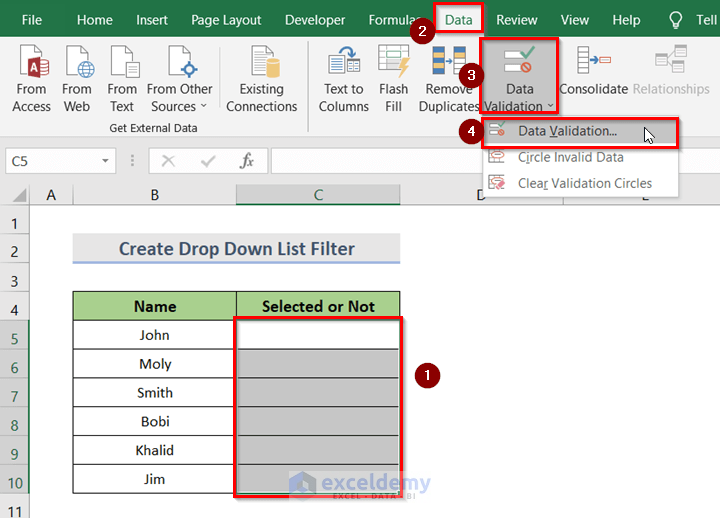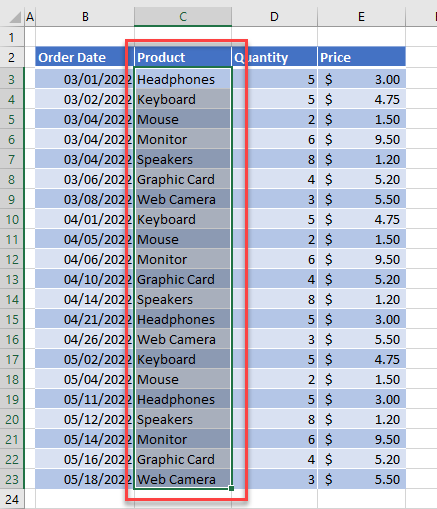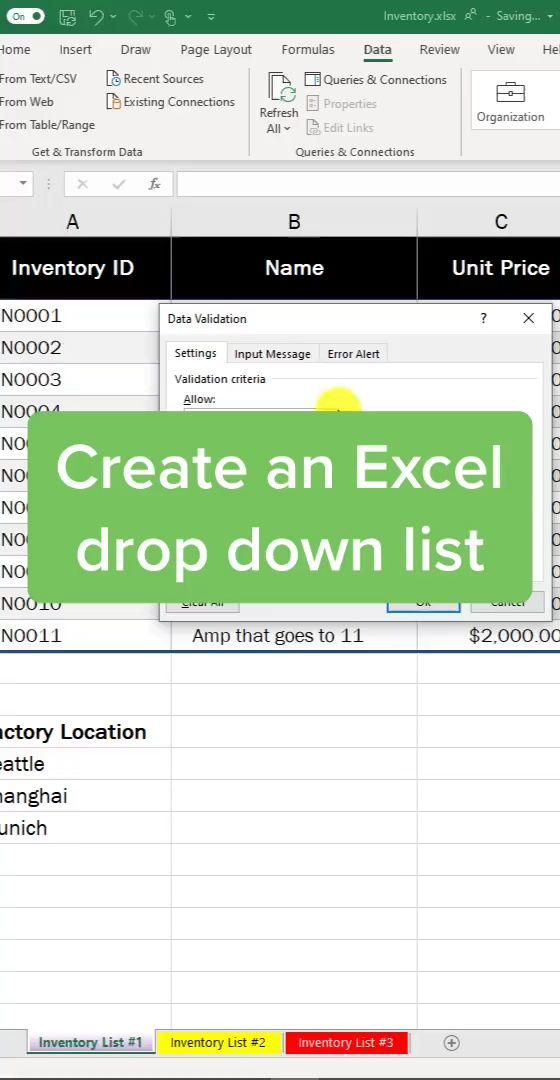Top 5 Filter Techniques for Excel Dropdowns

Excel, a powerhouse of data management and analysis, offers a plethora of tools to streamline your workflow. One such feature is the ability to create dropdown lists, which provide a user-friendly way to input data into your worksheets. When dealing with large datasets, the data entry process can become tedious and prone to errors. This is where filter techniques for Excel dropdowns come into play, ensuring accuracy and efficiency.
In this article, we delve into the top 5 filter techniques that will revolutionize your Excel dropdown experience. By mastering these techniques, you'll enhance your data validation process, making it easier to manage and analyze your data. So, let's dive in and explore the world of Excel dropdown filters, and learn how to maximize their potential.
The Power of Filter Techniques for Excel Dropdowns

Excel dropdowns, when combined with effective filter techniques, offer a robust solution for data validation. They provide a controlled and structured approach to data entry, minimizing the risk of errors and enhancing data consistency. By implementing these techniques, you’ll unlock a more organized and efficient data management system.
Furthermore, Excel dropdowns with filters empower you to create dynamic and interactive worksheets. Whether you're building financial models, conducting market research, or managing inventory, these techniques will streamline your processes and improve the overall user experience.
Technique 1: Dynamic Data Validation Lists

The first filter technique we’ll explore is the creation of dynamic data validation lists. This powerful feature allows you to automatically update your dropdown options based on specific criteria or changes in your dataset.
For instance, imagine you're managing a sales database. By using dynamic data validation, you can ensure that the dropdown list for "Product Categories" automatically updates whenever a new product is added to your inventory. This eliminates the need for manual updates and ensures that your dropdowns always reflect the latest data.
To implement dynamic data validation lists, you'll utilize Excel's powerful formulae, such as the OFFSET and COUNTA functions, combined with named ranges. By combining these elements, you can create a flexible and adaptive dropdown list that saves time and reduces errors.
Step-by-Step Guide to Dynamic Data Validation
- Identify the range of cells that contain the data you want to use for your dropdown list.
- Create a named range for this data by selecting the range and assigning a name to it (e.g., “ProductRange”).
- Use the DATA VALIDATION feature to create your dropdown list.
- In the Source field, enter a formula that references the named range and uses the OFFSET function to specify the range of cells to be included in the dropdown.
- For example:
=OFFSET(ProductRange, 0, 0, COUNTA(ProductRange), 1) - This formula ensures that the dropdown list always displays the full range of products, even if new products are added.
Technique 2: Custom Filter Lists
Custom filter lists allow you to create dropdown options tailored to your specific needs. This technique is ideal when you want to offer a more selective range of choices to your users.
For example, imagine you're creating a survey sheet to collect feedback on different aspects of a product. You can use custom filter lists to provide dropdown options that reflect the specific features or attributes of the product, ensuring respondents select relevant and accurate responses.
To create custom filter lists, you'll use Excel's DATA VALIDATION feature and manually input the desired options. This technique gives you full control over the dropdown content, allowing for precise data validation.
Step-by-Step Guide to Custom Filter Lists
- Select the cell where you want your dropdown list to appear.
- Go to the DATA tab and click on Data Validation.
- In the Allow dropdown, select List.
- In the Source field, manually enter the options you want to include in your dropdown list, separated by commas.
- For example:
“Excellent, Good, Average, Poor” - Click OK to apply the custom filter list.
Technique 3: Dependent Dropdowns
Dependent dropdowns, also known as cascading dropdowns, are a powerful tool for creating dynamic and interconnected data entry forms. This technique allows the options in one dropdown to depend on the selection made in another dropdown, creating a seamless and intuitive user experience.
For instance, consider a scenario where you're managing an online store with various product categories and subcategories. By using dependent dropdowns, you can ensure that the "Subcategory" dropdown only displays options relevant to the selected "Category." This not only simplifies the data entry process but also reduces the risk of errors.
To create dependent dropdowns, you'll leverage Excel's DATA VALIDATION feature in combination with named ranges and formulae like INDEX and MATCH. This technique ensures that your dropdowns work in harmony, providing a seamless data validation process.
Step-by-Step Guide to Dependent Dropdowns
- Create two named ranges: one for the “Category” dropdown (e.g., “CategoryRange”) and another for the “Subcategory” dropdown (e.g., “SubcategoryRange”).
- In the “Subcategory” dropdown, use a formula that references the “Category” dropdown and the “Subcategory” named range.
- For example:
=INDEX(SubcategoryRange, MATCH(CategoryRange, CategoryRange, 0), 0) - This formula ensures that the “Subcategory” dropdown displays options based on the selected “Category.”
Technique 4: Conditional Formatting for Dropdown Highlighting

Conditional formatting is a powerful Excel feature that allows you to visually emphasize specific cells based on certain conditions. When combined with dropdowns, it becomes a valuable tool for drawing attention to selected options and enhancing the user experience.
For example, imagine you're creating a customer feedback form with a dropdown list for rating customer satisfaction. By applying conditional formatting, you can make the selected rating stand out, making it easier for users to provide their feedback and for you to analyze the results.
To implement conditional formatting for dropdown highlighting, you'll use Excel's CONDITIONAL FORMATTING feature and create a rule that triggers when a dropdown cell is selected.
Step-by-Step Guide to Conditional Formatting
- Select the range of cells where your dropdowns are located.
- Go to the HOME tab and click on Conditional Formatting.
- Choose New Rule and select Use a formula to determine which cells to format.
- In the formula field, enter a formula that checks if the cell contains a value. For dropdowns, you can use the ISFORMULA function.
- For example:
=ISFORMULA(A1)(assuming your dropdown is in cell A1) - Define the formatting you want to apply when the condition is met. You can choose from various options like font color, cell fill, or borders.
- Click OK to apply the conditional formatting rule.
Technique 5: Error Alert Customization
By default, Excel’s data validation feature displays a generic error alert when invalid data is entered into a dropdown list. While this is useful, you can enhance the user experience by customizing these error alerts to provide more specific and helpful feedback.
For instance, imagine you're creating a budget planner with dropdowns for expense categories. If a user accidentally selects an invalid option, you can customize the error alert to provide a clear and friendly message, such as "Oops! Please select a valid expense category."
To customize error alerts, you'll use Excel's DATA VALIDATION feature and modify the error alert settings.
Step-by-Step Guide to Customizing Error Alerts
- Select the cell with the dropdown list.
- Go to the DATA tab and click on Data Validation.
- In the Error Alert tab, you can customize the title and message for the error alert.
- For example, you can set the title to “Invalid Selection” and the message to “Please choose a valid option from the dropdown.”
- Click OK to apply the customized error alert.
Conclusion
Excel dropdowns, when combined with these powerful filter techniques, become a dynamic and versatile tool for data validation. By mastering these techniques, you’ll enhance your data management skills, streamline your workflows, and create more interactive and user-friendly worksheets.
Remember, Excel is a versatile platform, and these techniques are just the tip of the iceberg. With practice and creativity, you can further customize and optimize your dropdowns to suit your specific needs. So, embrace the power of Excel dropdown filters and take your data management skills to new heights.
Can I combine multiple filter techniques in a single Excel dropdown?
+
Absolutely! You can combine different filter techniques to create complex and customized dropdowns. For example, you can use dynamic data validation and dependent dropdowns together to create a highly adaptive and interconnected data entry form.
Are there any limitations to the number of options I can have in an Excel dropdown list?
+
Excel has a practical limit of 32,767 unique items in a dropdown list. However, with creative use of named ranges and formulae, you can work around this limitation and create dropdowns with even larger datasets.
Can I apply filter techniques to existing Excel dropdowns, or do I need to start from scratch?
+
You can certainly apply filter techniques to existing dropdowns. Simply select the dropdown cell, navigate to the DATA tab, and choose Data Validation to edit the settings. From there, you can modify the validation criteria and customize the error alerts.
Are there any online resources or tutorials I can refer to for further learning on Excel dropdown filter techniques?
+
Absolutely! There are numerous online resources, including video tutorials and written guides, that delve deeper into Excel dropdown filter techniques. Websites like Excel Campus, Chandoo, and Excel Easy offer comprehensive tutorials and tips to help you master these techniques.


